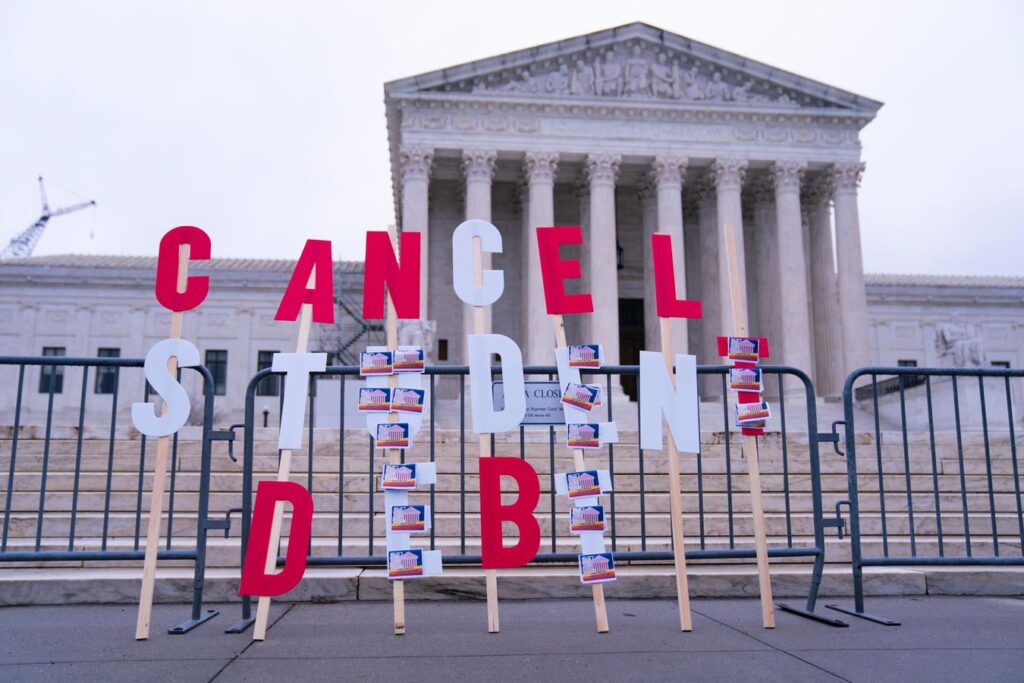WASHINGTON, UNITED STATES – FEBRUARY 28: A sign reading Cancel Student Debt is staged outside of the … [+]
The 8th Circuit Court of Appeals upheld the injunction blocking the SAVE (Saving on a Valuable Education) Plan earlier this week, and even expanded it to include other repayment plans like REPAYE. In the opinion written by the court, it was argued that the Department of Education does not have the authority to make rules granting loan forgiveness beyond what Congress explicitly authorized.
The result for borrowers is that the SAVE Plan will remain blocked, along with loan forgiveness under PAYE, REPAYE, and ICR. For borrowers in the SAVE forbearance, that will continue until everything is resolved.
In the longer term, it’s likely the SAVE plan will be eliminated altogether, but that will have to wait until the lower court rules or Congress acts. There’s also a scenario where the Trump Administration does appeal, but only to delay until Congress acts.
Either way, SAVE is effectively dead. It simply becomes a question of when.
What Borrowers On SAVE Need To know
For borrowers on the SAVE student loan repayment plan, nothing is changing in the short term. The administrative forbearance will continue until there is official clarity on the future of the program.
Even then, if the plan is eliminated, the Department of Education will need to make new rules and guidance for borrowers, which can take time. For example, they will need to decide which repayment plans are available and active, and if borrowers don’t select a new plan themselves, how will the Department of Education automatically move borrowers from SAVE into another plan?
If SAVE is eliminated soon, it’s likely that borrowers in the SAVE forbearance will likely have a significant amount of time before having to resume payments – likely through the summer or even into 2026.
It’s important to note that the court was very clear on two things:
- Income-Based Repayment (IBR) was created by Congress and explicitly includes student loan forgiveness.
- Public Service Loan Forgiveness (PSLF) was created by Congress and also explicitly allows loan forgiveness.
As such, these two programs are not in jeopardy from the recent court cases (though the Trump Administration has signaled they want to change repayment plan options). However, it’s likely there could be more changes on the horizon.
What Are The Next Steps For Borrowers
Borrowers currently in the SAVE plan will likely have to change to another repayment plan in the near future. When that will be is currently unknown, but borrowers should start the planning process, especially if you’re uncertain you can afford your future loan payments.
Right now, borrowers should take the following actions:
- Ensure that your contact information is updated with your loan servicer. This will ensure that you don’t miss any reminders for deadlines, repayment plan changes, or loan restarts. Last week borrowers were seeing their credit scores drop because they missed key repayment deadlines.
- Run the Student Loan Simulator to see what repayment plan options might be available and affordable.
- For borrowers pursuing PSLF, it might make sense to apply for IBR sooner in order to begin accumulating qualifying payments again.
- Use the remaining time in forbearance to pay off other debt or build up an emergency fund.
It’s important to remember that nothing is finalized yet. The SAVE plan is still in existence officially, and borrowers in the SAVE plan will remain in forbearance until the Department of Education finalizes new rules. Also, proposals in Congress are just that – proposals. There aren’t any legislative changes impacting borrowers yet.
It’s also a good time to remind borrowers to be vigilant against student loan scams. Whenever this is uncertainty around student loan repayment or forgiveness programs, scammers tend to prey on borrowers. Remember to validate any information on StudentAid.gov or via your loan servicer.
Finally, remember that loan servicers may not have up-to-the-minute information on changes. When SAVE is officially eliminated, it may take upwards of a week before loan servicers have accurate information they can communicate with borrowers.
Read the full article here
